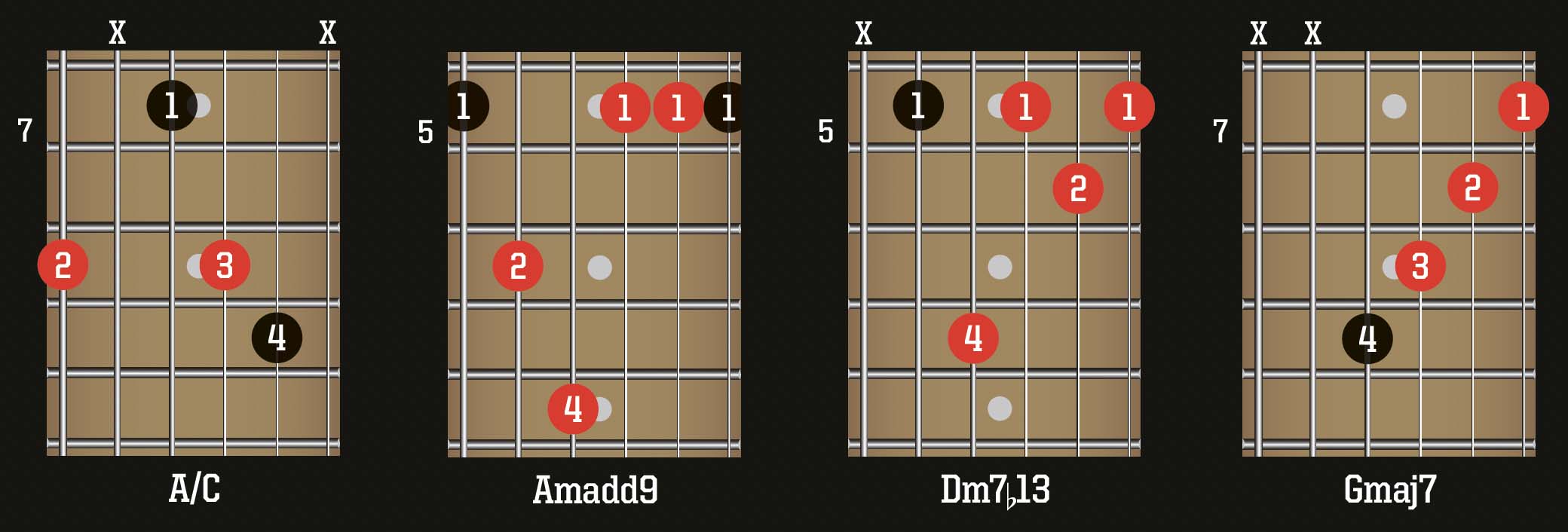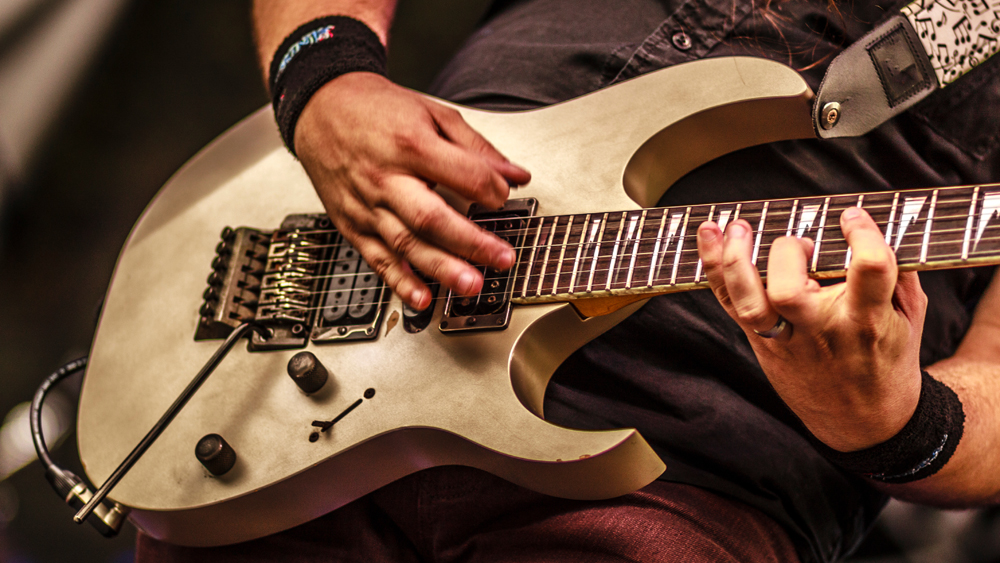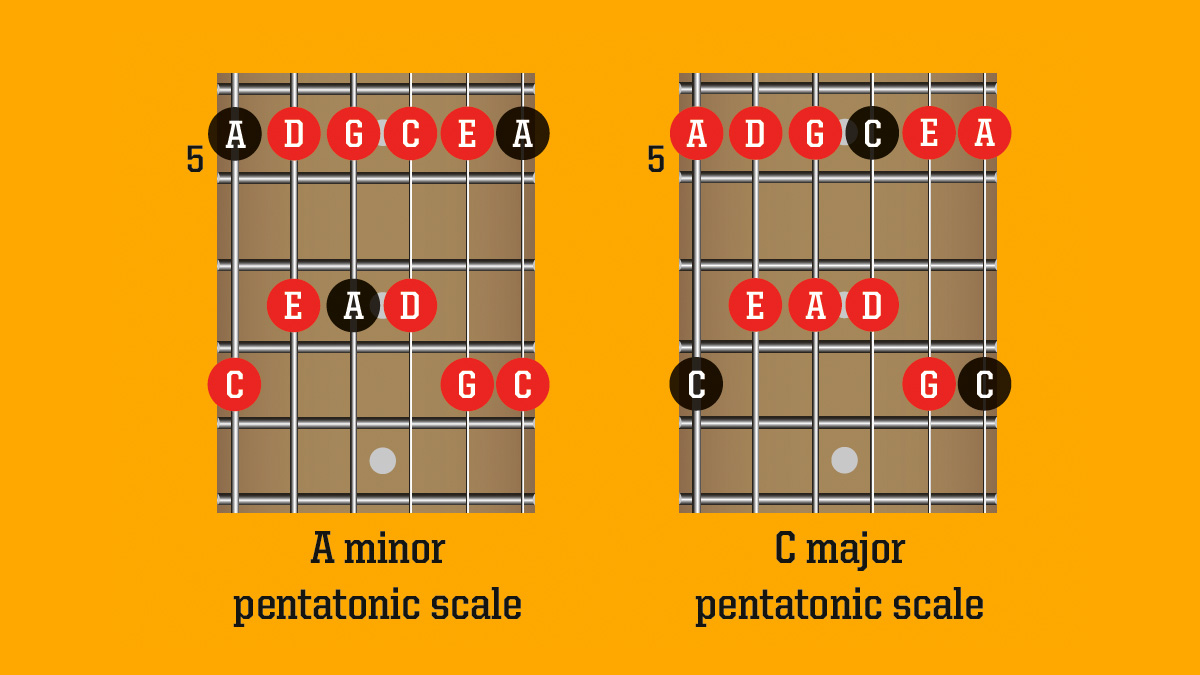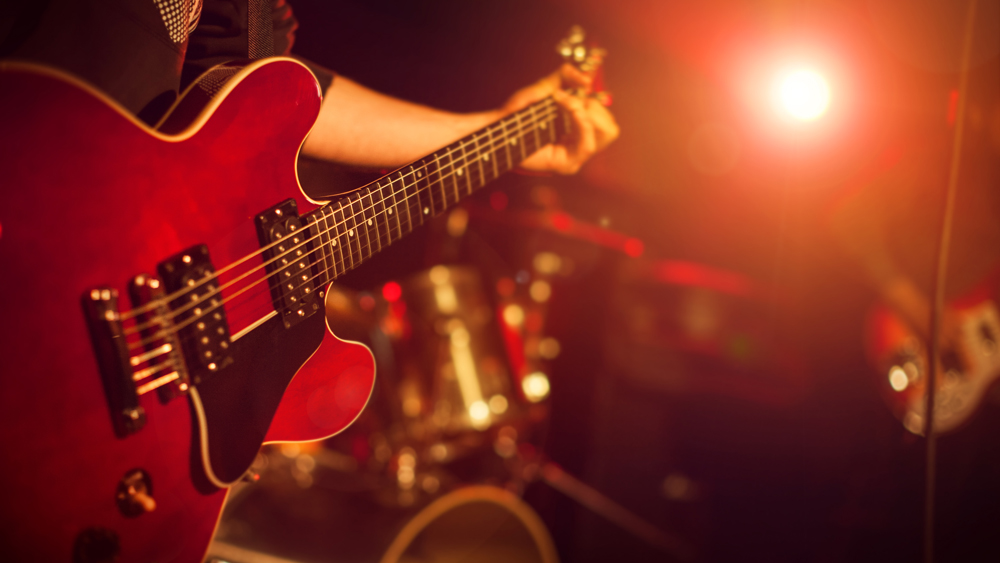10 ways to improve your live guitar playing
Shape up your playing and focus on the skills you need to be the best live guitarist you can be

It goes almost without saying that your playing skills need to be fully up to speed when playing live. When practicing, you need to focus on a mix of repertoire and core skills such as rhythm playing and basic lead techniques – it’s mostly about making sure you’ve got the basics down at this stage, rather than aiming for next-level practicing.
With that in mind, what follows is not so much a practice routine or a series of drills, but a broader set of exercises and concepts that’ll help you hone the relevant playing skills for playing live. Read on, plug in and get practicing!
1. Chord changes
Limber up your fingers with these challenging changes
File this under ‘essential playing skills’! Whether you’re playing live, recording in the studio or just jamming songs for fun, you’re going to need to have your chord changing skills down pat. And if you’ve not played a gig for a while, well, it’s a skill that might just need a little practice. Try out our tab exercise and you’ll see progress.

These shapes are real finger-twisters! Take your time learning how to fret each chord accurately before tackling the changes. Aim to fret right on your fingertips, and not on the front of your fingers.

Three tips for better chord changes
1. Practice playing full songs
The discipline required to play for four or five minutes straight will help you develop your muscle memory.
2. Play regularly
If you take an extended break from playing guitar your basic skills will suffer. Play a little every day to keep your changes pin-sharp.
3. Repeat tricky exchanges
Struggling to master a chord change? Isolate the shapes in question and practice the change over and over again at slow speed.

2. How to learn difficult songs
Our four-point plan will help you tackle the toughest tracks in your repertoire
Whether it’s a solo or a whole song, some pieces of music feel just too damn hard to master. Start by dedicating time to the easier parts. It may sound obvious, but get those easy lines down first – they’ll form a framework for the harder parts. From there, you’ll need a plan...
1. Fret-hand practice
Practicing one hand at a time lets you focus on specific areas. Starting with your fret hand, play a short section of your track without worrying about speed, timing or how you pick. Identify where you make mistakes and practice those parts slowly.
2. Pick-hand practice
Now, pick the strings without fretting any notes. Mute the strings then, starting slowly, pick the notes in order and home in on tricky points. Most likely, it’ll be a rake, an arpeggio or a skip to a non-adjacent string that’ll need practice.
3. Gloss over the hard parts
It may sound counter-intuitive but, now, ditch the most challenging parts and play a rough version of your song (or section). Literally, ditch all troublesome notes. Gradually reintroduce these notes one by one.
4. Practice short phrases
Most of the time you’ll at least be able to play short phrases from the tough songs you want to learn. Use that to your advantage and practice super-short lines. Just a few notes at a time will do. It’s just a matter of time before you start to link it all together.
3. Rhythm and timing
Master the basics
Great rhythm playing makes the difference between a good and a great performance – and with gigs looming, it’s a skill you must hone. For most rock and pop it’s more a matter of getting better at the basics (simple rhythms, strumming, and so on) rather than aiming at higher levels of virtuosity. Try our tab exercises and focus on delivering a fluid, even performance.

Keep your pick hand strumming in a constant down-up motion, following the underlying 16th-note rhythm. The challenge here is to miss the strings as needed – for example, the opening Badd11 chord lasts for eight 16th notes but you only strum five times.

Nile Rodgers is a master of chord embellishment as shown here in our Chic-inspired line. Funk and disco represent the gold standard for rhythm guitar, so, whether you play these styles or not, they should appear in your regular practice routine.
4. Coordination
Tidy up your playing with these challenging musical ideas
Sometimes as guitarists we can be too focused on developing technically without seeing the bigger picture. For example, working on your picking technique without also ensuring your fret hand can keep up might not give you the results you want. When it comes to playing live, it’s all about improving your all-round game, so these tab examples will ensure both hands get a workout.

This Muse-style riff is based on a challenging line phrased mainly around three-note groupings. With the steady 16th-note rhythm, this means each grouping starts at a different place in each beat. Use down-up style alternate picking and pay attention to the slides, which require greater control over when you are engaging the pick.

This exercise will help develop your fret-hand stretching and fingertip accuracy. You need to have a good hand position here, so aim to be in parallel with the fretboard with a good arch in your wrist. This will help prevent your hand angling diagonally in order to reach the bigger stretches.
5. Essential chord progressions
Learn these commonplace chord progressions and jam night will be easy!
A little knowledge of chord progressions will help you jam a long with songs you barely know. We’ll run through some basics in the key of C major here. Try playing the progressions as written in C, then see if you can work out the same sequences in another key, say G or A major. We’ll start with a look at the main chords found in C major.
1. I-IV-V (C-F-G)
The I-IV-V (one four five) is the undisputed champ of jam night chord progressions. E (E-A-B) and A (A-D-E) are common key signatures. Use dominant 7ths (E7, A7, etc) for a blues or rock ’n’ roll vibe.
2. II-V-I (DM7-G7-CMAJ7)
As heard in jazz standard Autumn Leaves, this progression moves in 4th intervals (D to G is a 4th; G to C is too) often using 7th and 9th chord voicings. You can continue the sequence in 4ths through F, Bdim and so on.
3. VI-V-IV (AM-G-F)
Bob Dylan’s All Along The Watchtower cycles through VI-V-IV-V chords. Dire Straits took a different tack in Sultans Of Swing, following the VI-V-IV with a dominant chord on the III. We’ll save you the theory.
4. V-IV-I (G-F-C)
The verse in GNR’s Sweet Child O’ Mine is a classic example of this progression, taking the chords from the key of G major (D-C-G) and using the V chord (D) as the tonal centre.
5. I-V-VI-IV (C-G-AM-F)
Possibly the most used progression in all of rock and pop music, it’s essential knowledge for any musician. Bob Marley’s No Woman, No Cry is in Db (Db-Ab-Bbm-Gb); more recently Taylor Swift used the progression in C in Champagne Problems.
6. I-VI-IV-V (C-AM-F-G)
This variant on the previous progression is often referred to as the '50s progression, thanks to its common usage at the time. Unchained Melody by the Righteous Brothers is a classic example.
6. Pentatonics
Essential scales and licks for any gigging guitarist
In rock and pop, pentatonic scales are a great starting point for any solo. A predictable option maybe, but that’s the point: pentatonics are easy to remember and easy to develop creatively.
Why is this relevant here? Well, if you’ve ever snapped a string mid-solo or if you’ve had to take the spotlight and deliver a solo when a fellow band member’s rig has failed, you’ll know how important it is to have backup soloing ideas. Our tab examples are simple pentatonic ideas that can be applied in almost any style of music. Essential stuff!

This features repeating hammer-ons and pull-offs that ascend through the A minor pentatonic scale (A, C, D, E, G). The scale fits neatly under the fingers in this scale shape and our lick is best used in classic rock or modern blues-rock-style lead lines. Play slowly at first, and focus on developing your feel and timing

This exercise extends the scale into the next fretboard position. This is a useful extension, because not only can different types of licks be played, but there’s a higher note, too.
The magic scale

These two scales are identical shapes, but they are different scales. Start on the A note and you get the A minor pentatonic scale; start on C and you have C major pentatonic. It means you can use this one shape in both major and minor keys. Just identify the root note for the key you want to play in.
7. Improvising solos
Play a solo on the spot with three easy ideas
If you’re stepping into the spotlight to take an impromptu improvised solo, TG’s advice is to apply some practical limitations to your playing then develop your ideas from there. The idea is to focus on easy techniques so that you don’t become overawed by the seemingly limitless other ways that you could be improvising.
1. Start with one note
Sticking to one note might not sound like a recipe for a world-class ad lib, but as a way to make up a solo on the spot, it’s brilliant. Assuming you know what key you’re in, we advise starting on a root note. By ditching all other notes, you can focus on playing a simple rhythmic lick, getting a feel for where to play on the fretboard. Then, as your ideas take shape...
2. Introduce more notes
And which notes should you use next? Well, before you go deeper into potential scale choices, start with a note that’s nearby on the fretboard, using your ear to make the choice. Build a one‑note rhythmic lick up into a two-, three- or four note phrase – you’ll probably be starting to spot scale patterns you already know now.

Another self-imposed 'limitation' to try out is the one-string jam. By closing off all the other notes on the fretboard you'll have fewer soloing options. What sounds like a drawback actually allows you to focus on a simpler approach. Have a go at this tab example and experiment with slides, hammer-ons, pull-offs and try adding other notes, too.
8. Essential lead skills: Legato
A key technique for any guitarist, whatever style you play
Legato refers to the combination of hammer-ons and pull-offs – and that means it’s one of the most commonly used playing techniques of all. Whether or not you consider yourself a lead player, there’s plenty to be gained from a little practice in this area. It’s as relevant to single-note riffing and Mayer-esque chord embellishments as it is to blazing shred licks. Our tab exercises will help you get all four fretting fingers working as a unit.
Legato: Just hammer-ons

Start by lightly picking the 5th fret note, then drop your third, then fourth finger onto the string. Keep repeating this and try to make all three notes the same volume – a crucial part of legato lead playing. Use the same approach on the next two strings, keeping the unused lower strings muted with the side of your picking palm.
Legato: Just pull-offs

Pick each downbeat using either all downstrokes, or alternating between down- and upstrokes. Play the ‘in between’ notes with pull-offs and really focus on making the timing of the triplet rhythms even; there should be three equal-length notes per beat throughout the exercise.
9. Essential lead skills: Picking
Timing, expressiveness and speed are all determined how you pick
If legato is one side of the essential lead guitar playing coin, picking is the other. It’s a technique that determines your timing, and, given that this is how you articulate most notes, it’s a vital expressive tool as well. This vital part of guitar playing should appear in everyone’s routine, whether as a simple warm-up before a longer playing session or as part of a more substantial lead guitar-focused practice plan.
Picking: Easy arpeggios

The picking directions reveal all here! Traditional alternate picking would mean tricky changes of direction and you might have to use hammer-ons and pull-offs. The more economical way of picking ensures your pick hand is always travelling in the direction of the next note. Try applying these shapes next time you’re improvising a solo.
Picking and pull-offs

This classic '80s-style lick uses a double downstroke to maximize the shredability! That means you can build your picking speed without so much physical effort.
The challenging part is the slight pause after the upstroke. Try to move your pick hand into position for the next note while you play the pull-off, aiming for steady timing as you do so.

10. Overcome gig nerves
Take control of your gigging environment and beat on-stage nervousness
Our best tip for beating gig nerves is to take control of every possible element of your performance. In our experience, using tried and trusted equipment and playing well-rehearsed songs makes for a fun, stress-free experience. And ask yourself, what are you nervous about? If it’s something you can prepare for, go ahead, you know what to do!
1. Know how your gear works
Does your drive pedal give you enough boost? Can you hear your amp over your drummer? Gigs are hassle-free if you’re familiar with your gear.
2. Anticipate gear failures
Strings snap, batteries run out, even valves can blow. A box of spares in your arsenal is a big stress-reliever.
3. Visit the venue
If possible, visit the venue ahead of your gig. Familiar environments feel, well, familiar! You’ll feel more at home on gig night.
4. Make the stage your own
Take the time to make room for your gear. Don’t let a rushed soundcheck prevent you from getting set up.
5. Practice, practice, practice
You’re more likely to make mistakes if you haven’t learnt your songs. If there’s a piece you often bungle, try simplifying the section of music in question.
6. Warm up
A long wait between soundcheck and gig leads to cold muscles. Keep a guitar with you and warm up with a few exercises before going on stage.
Get The Pick Newsletter
All the latest guitar news, interviews, lessons, reviews, deals and more, direct to your inbox!
Total Guitar is one of Europe's biggest guitar magazines. With lessons to suit players of all levels, TG's world-class tuition is friendly, accessible and jargon-free, whether you want to brush up on your technique or improve your music theory knowledge. We also talk to the biggest names in the world of guitar – from interviews with all-time greats like Brian May and Eddie Van Halen to our behind the scenes Rig Tour features, we get you up close with the guitarists that matter to you.











